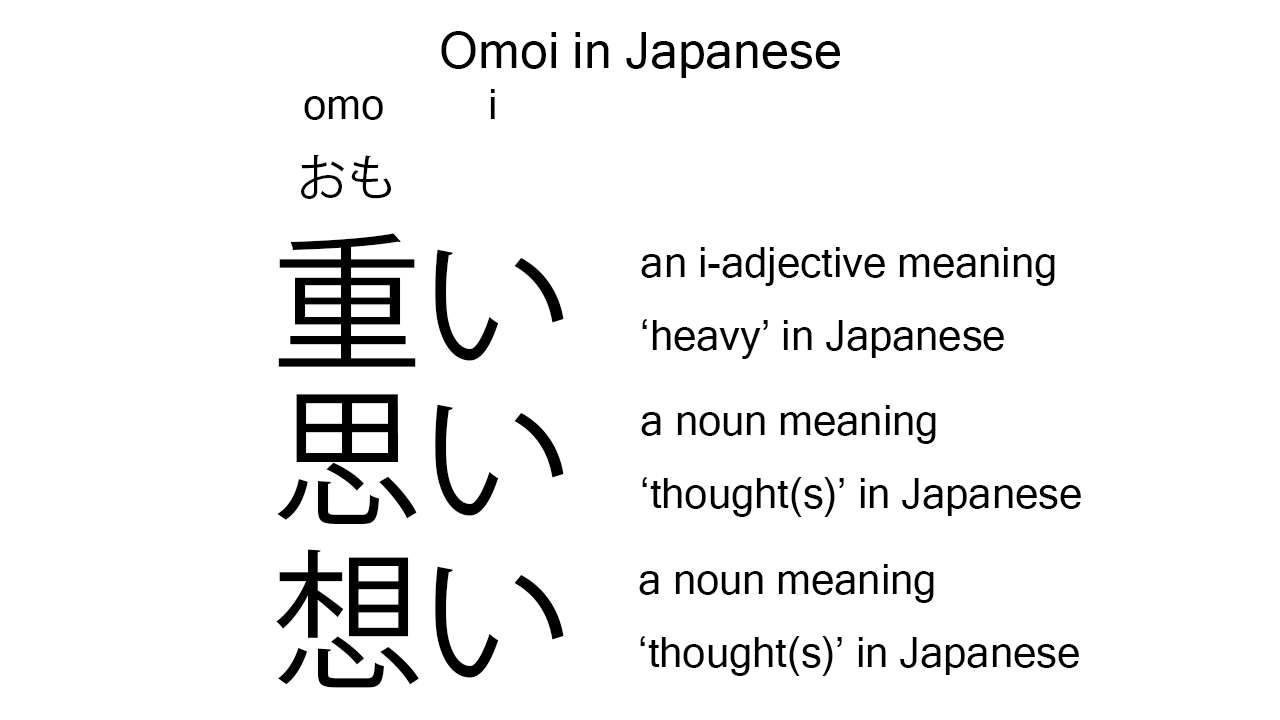What does “omoi” mean in Japanese?
There are so many homophones in Japanese. “Omoi” is one of them. Native speakers say it normally to mean ‘heavy’ or ‘thought’ in Japanese. Perhaps, some Japanese learners know this word as it is sometimes used in Japanese conversations. In this blog post, however, I will explain it together with its three different kanji expressions. And also, I will explain how to use it through example sentences. My explanations would help Japanese learners understand “omoi” more clearly. Then, let’s get started!
Contents
Omoi as an adjective
Let me start with “omoi” as an adjective:
- omoi – 重い (おもい) : an i-adjective meaning ‘heavy’ in Japanese. Depending on the context and situation, this can also mean ‘important’ or ‘serious’ in Japanese.
Normally, this kanji expression is used to mean ‘heavy’ in Japanese. It’s also worth mentioning here that this kanji character sometimes works as a prefix or suffix to add the meaning of ‘heavy’, ‘important’, or ‘serious’.
The definition and meanings are not that difficult, I think. Then, let me explain how to use this type of “omoi” through the example sentence below.
Example #1: how to say “heavy” in Japanese
watashi no kaban wa omoi – 私の鞄は重い (わたしのかばんはおもい)
My bag is heavy.
Below are the new words used in the example sentence.
- watashi – 私 (わたし) : a pronoun meaning ‘I’ in Japanese.
- no – の : a case particle used after a noun or pronoun to make its possessive case. In the example, this is used after “watashi” to make its possessive case, “watashi no“, which means ‘my’ in Japanese.
- kaban – 鞄 (かばん) : a noun meaning ‘bag’ in Japanese. This can also work as plural. Learn more about Japanese plural.
- wa – は : a binding particle working as a case marker or topic marker. In the example, this works after “watashi no kaban” to make the subject in the sentence.
This is a typical usage of this type of “omoi”. It is an i-adjective and therefore can work as the complement in the sentence. Like other adjectives, however, it can also work as a modifier in front of a noun. For example, we can say “omoi kaban” to mean a ‘heavy bag’ in Japanese. Anyway, when we want to mean ‘heavy’ in Japanese, this i-adjective is a very good option.
Omoi as a noun
Next, let me explain “omoi” as a noun.
- omoi – 思い/想い (おもい) : a noun meaning ‘thought’, ‘mind’, ‘feeling’, ‘love’, or ‘expectation’ in Japanese. This can also work as plural.
As a noun, “omoi” can be written in two different ways in kanji: 思い and 想い. The first one is more widely used; the second is used in particular fields like literature. So, basically we can focus on the first one. Both have the same meanings, though.
The definition and meanings are not that difficult, I think. Let me explain how to use this type of “omoi” through the example sentence below.
Example #2: how to say “thoughts” in Japanese
boku wa kanojo ni omoi wo tsutae ta – 僕は彼女に思いを伝えた (ぼくはかのじょにおもいをつたえた)
I conveyed my thoughts to her.
Below are the new words used in the example sentence.
- boku – 僕 (ぼく) : a pronoun meaning ‘I’ in Japanese. This is used mainly by boys and young males.
- kanojo – 彼女 (かのじょ) : a pronoun meaning ‘she’ in Japanese.
- ni – に : a case particle used to say in which direction an action goes. In the example, this is used after “kanojo” to say to whom the speaker conveyed the thoughts.
- wo – を : a case particle used to make the object word in a sentence. In the example, this is used after “omoi” to make the object in the sentence.
- tsutae – 伝え (つたえ) : one conjugation of the verb, “tsutaeru“, which means ‘to tell’ or ‘to convey’ in Japanese. In the example, it has been conjugated for the better connection with its following word.
- ta – た : an auxiliary verb used after a verb, adjective, or auxiliary verb to make its past tense form. In the example, this is used after “tsutae” to make its past tense form, “tsutae ta”.
This is a typical usage of this type of “omoi”. In the example, it means ‘thoughts’ in Japanese and works together with the case particle, “wo”, to become the object in the sentence.
In this example, “思い” is used. If “想い” were used instead, a sentence would become more poetic and romantic. When we want to make sentences sound poetic and romantic, the second kanji expression would be very helpful. Conversely, when we don’t, we should stick to the first one to avoid any possible misunderstanding.
Summary
In this blog post, I’ve explained the definitions and meanings of “omoi” together with its three different kanji expressions. And also, I’ve explained how to use it through the example sentences. Let me summarize them as follows.
- omoi – 重い (おもい) : an i-adjective meaning ‘heavy’ in Japanese. Depending on the context and situation, this can also mean ‘important’ or ‘serious’ in Japanese.
- omoi – 思い/想い (おもい) : a noun meaning ‘thought’, ‘mind’, ‘feeling’, ‘love’, or ‘expectation’ in Japanese. This can also work as plural. The first kanji expression is more widely used; the second is used in particular fields like literature. When we want to make sentences sound poetic and romantic, the second kanji expression would be very helpful. Conversely, when we don’t, we should stick to the first one to avoid any possible misunderstanding.

Hope my explanations are understandable and helpful for Japanese learners.